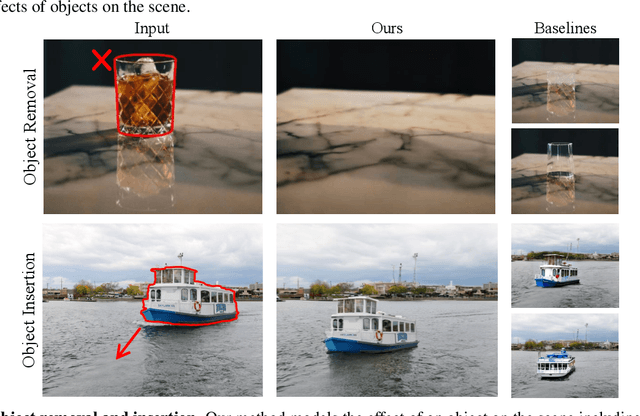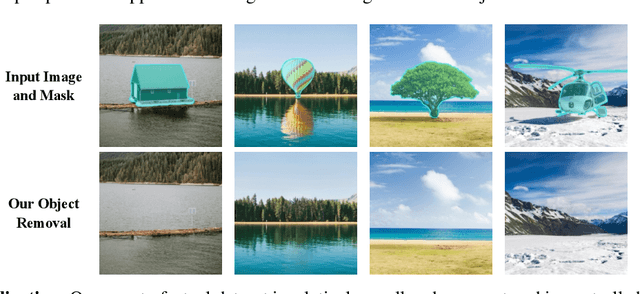Shlomi Fruchter
Diffusion Models Are Real-Time Game Engines
Aug 27, 2024Abstract:We present GameNGen, the first game engine powered entirely by a neural model that enables real-time interaction with a complex environment over long trajectories at high quality. GameNGen can interactively simulate the classic game DOOM at over 20 frames per second on a single TPU. Next frame prediction achieves a PSNR of 29.4, comparable to lossy JPEG compression. Human raters are only slightly better than random chance at distinguishing short clips of the game from clips of the simulation. GameNGen is trained in two phases: (1) an RL-agent learns to play the game and the training sessions are recorded, and (2) a diffusion model is trained to produce the next frame, conditioned on the sequence of past frames and actions. Conditioning augmentations enable stable auto-regressive generation over long trajectories.
Imagen 3
Aug 13, 2024Abstract:We introduce Imagen 3, a latent diffusion model that generates high quality images from text prompts. We describe our quality and responsibility evaluations. Imagen 3 is preferred over other state-of-the-art (SOTA) models at the time of evaluation. In addition, we discuss issues around safety and representation, as well as methods we used to minimize the potential harm of our models.
Magic Insert: Style-Aware Drag-and-Drop
Jul 02, 2024Abstract:We present Magic Insert, a method for dragging-and-dropping subjects from a user-provided image into a target image of a different style in a physically plausible manner while matching the style of the target image. This work formalizes the problem of style-aware drag-and-drop and presents a method for tackling it by addressing two sub-problems: style-aware personalization and realistic object insertion in stylized images. For style-aware personalization, our method first fine-tunes a pretrained text-to-image diffusion model using LoRA and learned text tokens on the subject image, and then infuses it with a CLIP representation of the target style. For object insertion, we use Bootstrapped Domain Adaption to adapt a domain-specific photorealistic object insertion model to the domain of diverse artistic styles. Overall, the method significantly outperforms traditional approaches such as inpainting. Finally, we present a dataset, SubjectPlop, to facilitate evaluation and future progress in this area. Project page: https://magicinsert.github.io/
ObjectDrop: Bootstrapping Counterfactuals for Photorealistic Object Removal and Insertion
Mar 27, 2024



Abstract:Diffusion models have revolutionized image editing but often generate images that violate physical laws, particularly the effects of objects on the scene, e.g., occlusions, shadows, and reflections. By analyzing the limitations of self-supervised approaches, we propose a practical solution centered on a \q{counterfactual} dataset. Our method involves capturing a scene before and after removing a single object, while minimizing other changes. By fine-tuning a diffusion model on this dataset, we are able to not only remove objects but also their effects on the scene. However, we find that applying this approach for photorealistic object insertion requires an impractically large dataset. To tackle this challenge, we propose bootstrap supervision; leveraging our object removal model trained on a small counterfactual dataset, we synthetically expand this dataset considerably. Our approach significantly outperforms prior methods in photorealistic object removal and insertion, particularly at modeling the effects of objects on the scene.
PALP: Prompt Aligned Personalization of Text-to-Image Models
Jan 11, 2024



Abstract:Content creators often aim to create personalized images using personal subjects that go beyond the capabilities of conventional text-to-image models. Additionally, they may want the resulting image to encompass a specific location, style, ambiance, and more. Existing personalization methods may compromise personalization ability or the alignment to complex textual prompts. This trade-off can impede the fulfillment of user prompts and subject fidelity. We propose a new approach focusing on personalization methods for a \emph{single} prompt to address this issue. We term our approach prompt-aligned personalization. While this may seem restrictive, our method excels in improving text alignment, enabling the creation of images with complex and intricate prompts, which may pose a challenge for current techniques. In particular, our method keeps the personalized model aligned with a target prompt using an additional score distillation sampling term. We demonstrate the versatility of our method in multi- and single-shot settings and further show that it can compose multiple subjects or use inspiration from reference images, such as artworks. We compare our approach quantitatively and qualitatively with existing baselines and state-of-the-art techniques.
Style Aligned Image Generation via Shared Attention
Dec 04, 2023Abstract:Large-scale Text-to-Image (T2I) models have rapidly gained prominence across creative fields, generating visually compelling outputs from textual prompts. However, controlling these models to ensure consistent style remains challenging, with existing methods necessitating fine-tuning and manual intervention to disentangle content and style. In this paper, we introduce StyleAligned, a novel technique designed to establish style alignment among a series of generated images. By employing minimal `attention sharing' during the diffusion process, our method maintains style consistency across images within T2I models. This approach allows for the creation of style-consistent images using a reference style through a straightforward inversion operation. Our method's evaluation across diverse styles and text prompts demonstrates high-quality synthesis and fidelity, underscoring its efficacy in achieving consistent style across various inputs.
AnyLens: A Generative Diffusion Model with Any Rendering Lens
Nov 29, 2023Abstract:State-of-the-art diffusion models can generate highly realistic images based on various conditioning like text, segmentation, and depth. However, an essential aspect often overlooked is the specific camera geometry used during image capture. The influence of different optical systems on the final scene appearance is frequently overlooked. This study introduces a framework that intimately integrates a text-to-image diffusion model with the particular lens geometry used in image rendering. Our method is based on a per-pixel coordinate conditioning method, enabling the control over the rendering geometry. Notably, we demonstrate the manipulation of curvature properties, achieving diverse visual effects, such as fish-eye, panoramic views, and spherical texturing using a single diffusion model.
The Chosen One: Consistent Characters in Text-to-Image Diffusion Models
Nov 27, 2023Abstract:Recent advances in text-to-image generation models have unlocked vast potential for visual creativity. However, these models struggle with generation of consistent characters, a crucial aspect for numerous real-world applications such as story visualization, game development asset design, advertising, and more. Current methods typically rely on multiple pre-existing images of the target character or involve labor-intensive manual processes. In this work, we propose a fully automated solution for consistent character generation, with the sole input being a text prompt. We introduce an iterative procedure that, at each stage, identifies a coherent set of images sharing a similar identity and extracts a more consistent identity from this set. Our quantitative analysis demonstrates that our method strikes a better balance between prompt alignment and identity consistency compared to the baseline methods, and these findings are reinforced by a user study. To conclude, we showcase several practical applications of our approach. Project page is available at https://omriavrahami.com/the-chosen-one
 Add to Chrome
Add to Chrome Add to Firefox
Add to Firefox Add to Edge
Add to Edge